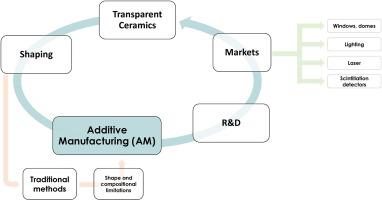Industrial potential of additive manufacturing of transparent ceramics: A review
IF 2.9
Q1 MATERIALS SCIENCE, CERAMICS
引用次数: 0
Abstract
Transparent ceramics is a unique class of materials, with performance comparable to single crystals, but a high process flexibility given by ceramic technology. Currently, traditional ceramic shaping technologies reliably produce components but are limited in terms of shapes and the use of multiple compositions in a single component. The presented review aims to illustrate how the introduction of additive manufacturing (AM) technology in the production of transparent ceramic components opens new possibilities, both thanks to the high variability of shapes and thanks to the high precision in producing parts with a controlled variation of composition. Within this review, several AM techniques and their current state of the art are analysed, with focus on their advantages in producing transparent ceramics, along with the associated challenges and limitations. The future perspective and possibilities for an industrial production are discussed, with emphasis on the most promising AM techniques, direct ink writing and vat photopolymerisation, pointing out the future scenario for the transparent ceramics market.

透明陶瓷增材制造的工业潜力:综述
透明陶瓷是一类独特的材料,其性能可与单晶体相媲美,但陶瓷技术赋予了其高度的工艺灵活性。目前,传统的陶瓷成型技术可以可靠地生产部件,但在形状和在单个部件中使用多种成分方面受到限制。本综述旨在说明在透明陶瓷部件的生产中引入快速成型(AM)技术是如何开辟新的可能性的,这既得益于形状的高可变性,也得益于在生产部件时对成分变化的高精度控制。在这篇综述中,分析了几种 AM 技术及其当前的技术水平,重点是它们在生产透明陶瓷方面的优势,以及相关的挑战和局限性。文章还讨论了工业化生产的未来前景和可能性,重点是最有前途的 AM 技术、直接墨水写入技术和大桶光聚合技术,并指出了透明陶瓷市场的未来前景。
本文章由计算机程序翻译,如有差异,请以英文原文为准。
求助全文
约1分钟内获得全文
求助全文
来源期刊

Open Ceramics
Materials Science-Materials Chemistry
CiteScore
4.20
自引率
0.00%
发文量
102
审稿时长
67 days
 求助内容:
求助内容: 应助结果提醒方式:
应助结果提醒方式:


